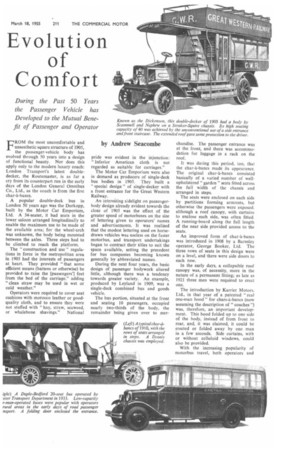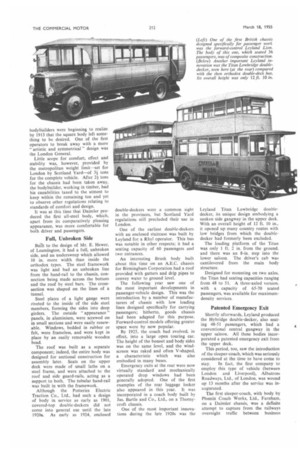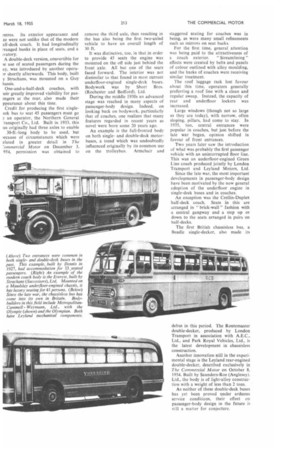Evolution of Comfort
Page 127

Page 128

Page 129

If you've noticed an error in this article please click here to report it so we can fix it.
During the Past 50 Years the Passenger Vehicle has Developed to the Mutual Benefit of Passenger and Operator
by Andrew Seacombe
FROM the most uncomfortable and unaesthetic square structure of 1905, the passenger-vehicle body has evolved through 50 years into a design of functional beauty. Nor does this apply only to the modern luxury coach: London Transport's latest doubledecker, the Routemaster, is as far a cry from its counterpart run in the early days of the London General Omnibus Co., Ltd., as the coach is from the first char-h-bancs.
A popular double-deck bus in London 50 years ago was the Durk opp, built by the Motor Car Emporium, Ltd. A 34-seater, it had seats in the lower saloon arranged longitudinally to enable the maximum use to be made of the available area; for the wheel-arch was unknown, the body being mounted between the axles. Three steps had to be climbed to reach the platform.
The "construction and usc " regulations in force in the metropolitan area in 1905 had the interests of passengers at heart. They provided "that some efficient means (battens or otherwise) be provided to raise the [passengers'] feet from the bed of the carriage," adding "clean straw may be used in wet or cold weather."
Operators were required to cover seat cushions with morocco leather or goodquality cloth, and to ensure they were not stuffed with "hay, straw, seaweed, or whalebone shavings." National pride was evident in the injunction: "Inferior American cloth is not regarded as suitable for carriages."
The Motor Car Emporium were also in demand as producers of single-deck bus bodies in 1905. They built a "special design" of single-decker with a front entrance for the Great Western Railway.
An interesting sidelight on passengerbody design already evident towards the close of 1905 was the effect of the greater speed of motorbuses on the size of lettering given to operators' names and advertisements. It was realized that the modest lettering used on horsedrawn vehicles was useless on the faster motorbus, and transport undertakings began to contract their titles to suit the space available, setting the precedent for bus companies becoming known generally by abbreviated names.
During the next four years, the basic design of passenger bodywork altered little, although there was a tendency towards greater variety. An example, produced by Leyland in 1909, was a single-deck combined bus and goods vehicle.
The bus portion, situated at the front and seating 10 passengers, occupied nearly two-thirds of the body, the remainder being given over to mer ehandlse. The passenger entrance was at the front, and there was accommodation for luggage in a rack on the roof.
It was during this period, too, that the char-a-banes made its appearance. The original char-a-bancs consisted basically of a varied number of wellupholstered " garden " seats fitted across the full width of the chassis and arranged in steps.
The seats were enclosed on each side by partitions forming armrests, but otherwise the passengers were exposed. although a roof canopy, with curtains to enclose each side, was often fitted. A running-board along the full length of the near side provided access to the seats.
An improved form of char-h-bancs was introduced in 1908 by a Barnsley operator, George Booker, Ltd. The three rows of seats in this design were on a level, and there were side doors to each row.
In the early days, a collapsible roof canopy was, of necessity, more in the nature of a permanent fitting; as late as 1921 three men were required to erect one.
The introduction by Karrier Motors, Ltd., in that year of a patented "real one-man hood" for chars-b-bancs (now assuming the description of "coaches") was, therefore, an important development. This hood folded up to one side of the body, instead of from front to rear, and, it was claimed, it could be erected or folded away by one man in a few seconds. Side curtains, with or without celluloid windows, could also be provided.
With the increasing popularity of motorbus travel, both operators and bodyblilders were beginning to realize by 1913 that the square body left something to be desired. One of the first operators to break away with a more "artistic and symmetrical" design was the London General.
Little scope for comfort, effect and stability was, however, provided by the metropolitan weight limit—set for London by Scotland Yard—of 3i tons for the complete vehicle. After 21 tons for the chassis had been taken away, the bodybuilder, working in timber, had his capabilities taxed to the utmost to keep within the remaining ton and yet to observe other regulations relating to standards of comfort and design.
It was at this time that Daimler produced the first all-steel body, which, apart from its comparatively pleasing appearance, was more comfortable for both driver and passengers_
Full, Unbroken Side
Built to the design of Mr. E. Hewer, of Leamington, it had a full, unbroken side, and an undersweep which allowed 10 in. more width than inside the orthodox types. The steel framework was light and had an unbroken line from the hand-rail to the chassis, connection being made across the bottom and the roof by steel bars. The crosssection was shaped on the lines of a tunnel.
Steel plates of a light gauge were riveted to the inside of the side steel members, forming the sides into deep girders. The outside " appearance " panels, in aluminium, were screwed on in small sections and were easily renewable. Windows, bedded in rubber or felt, were frameless, and were kept in place by an easily removable wooden bead.
The roof was built as a separate component; indeed, the entire body was designed for sectional construction for assembly later. Seats on the upper deck were made of small laths on a steel frame, and were attached to the roof and side guard-rails, acting as a support to both. The tubular hand-rail was built in with the framework.
Although the Potteries Electric Traction Co., Ltd., had such a design of body in service as early as 1901, covered-top double-deckers did not come into general use until the late 1920s. As early as 1924, enclosed double-deckers were a common sight in the provinces, but Scotland Yard regulations still precluded their use in London.
One of the earliest double-deckers with an enclosed staircase was built by Leyland for a Rhyl operator. This bus was notable in other respects; it had a seating capacity of 60 passengers and two entrances.
An interesting Brush body built about this time on an A.E.C. chassis for Birmingham Corporation had a roof provided with gutters and drip pipes to convey water to ground level.
The following year saw one of the most important developments in passenger-vehicle design. This was the introduction by a number of manufacturers of chassis with low loading lines designed specifically for carrying passengers; hitherto, goods chassis had been adapted for this purpose. Forward-control models offering greater space were by now popular.
By 1925, the coach had evolved, in effect, into a large open touring car_ The height of the bonnet and body sides was on the same level, and the windscreen was raked and often V-shaped, a characteristic which was also embodied in many buses.
Emergency exits at the rear were now virtually standard and mechanically operated drop windows had been generally adopted. One of the first examples of the rear luggage locker also appeared in this year. It was incorporated in a coach body built by Jas. Bartle and Co., Ltd., on a Thornycroft chassis.
One of the most important innovations during the late 1920s was the Leyland Titan Lowbridge double' decker, its unique design embodying a sunken side gangway in the upper deck, With an overall height of 12 ft. 10 in., it opened up many country routes with low bridges from which the doubledecker had formerly been excluded.
The loading platform of the Titan was only 1 ft. 2 in. from the ground. and there was an 8-in, step into the lower saloon. The driver's cab was cantilevered from the main body structure.
Designed for mounting on two axles, the Titan had seating capacities ranging from 48 to 51. A three-axled version. with a capacity of 65-70 seated passengers, was available for maximumdensity services.
Patented Emergency Exit
Shortly afterwards, Leyland produced the Hybridge double-decker, also seating 48-51 passengers, which had a conventional central gangway in the upper saloon. All these bodies incorporated a patented emergency exit from the upper deck.
This period, too, saw the introduction of the sleeper-coach, which was seriously considered at the time to have come to stay. In fact, the first company to employ this type of vehicle (between London and Liverpool), Albatross Roadways, Ltd., of London, was wound up 13 months after the service was inaugurated.
The first sleeper-coach, with body by Phoenix Coach Works, Ltd., Farnham, on a Daimler chassis, was a definite attempt to capture from the railways overnight traffic between business
!lures. Its exterior appearance and ze were not unlike that of the modern alf-deck coach, It had longitudinally rranged bunks in place of seats, and a ,vatory.
A double-deck version, convertible for le use of seated passengers during the ay, was introduced by another operaiT shortly afterwards. This body, built y Strachans, was mounted on a Guy hassis.
One-and-a-half-deck coaches, with ikeir greatly improved visibility for pasmgers at the rear, also made their ppearance about this time.
Credit for producing the first singleeck bus to seat 45 passengers must go ) an operator, the Northern General 'ransport Co., Ltd. Built in 1933, this us originally had three axles to enable 30-ft.-long body to be used, but ,ecause of circumstances which were elated in greater detail in The 'ommercial Motor on December 3. 954. permission was obtained to remove the third axle, thus resulting in the bus also being the first two-axled vehicle to have an overall length of 30 ft.
It was distinctive, too, in that in order to provide 45 seats the engine was mounted on the off side just behind the front axle. All but one of the seats faced forward. The interior was not dissimilar to that found in most current underfloor-engined single-deck buses. Bodywork was by Short Bros. (Rochester and Bedford), Ltd.
During the middle 1930s an advanced stage was reached in many aspects of passenger-body design. Indeed, on looking back on bodywork, particularly that of coaches, one realizes that many features regarded in recent years as novel were born some 20 years ago.
An example is the full-fronted body on both singleand double-deck motorbuses, a trend which was undoubtedly influenced originally by its common use on the trolleybus. Armchair and staggered seating for coaches was in being, as were many small refinements such as mirrors on seat backs.
For the first time, general attention was being paid to the attractiveness of a coach exterior. " Streamlining " effects were created by belts and panels of colour outlined with alloy moulding, and the backs of coaches were receiving similar treatment.
The roof luggage rack lost favour about this time, operators generally preferring a roof line with a clean and regular sweep. Instead, the capacity of rear and underfloor lockers was increased.
Large windows (though not so large as they are today), with narrow, often sloping, pillars, had come to stay. In 1935, too, central entrances were popular in coaches, but just before the late war began, opinion shifted in favour of front entrances.
Two years later saw the introduction of what was probably the first passenger vehicle with an uninterrupted floor This was an underfloor-engined Green Line coach produced jointly by London Transport and Leyland Motors, Ltd.
Since the late war, the most important developments in passenger-body design have been motivated by the now general adoption of the underfloor engine in single-deck buses and in coaches.
An exception was the Crellin-Duplex half-deck coach. Seats in this are arranged in " brick-wall " fashion with a central gangway and a step up or down to the seats arranged in pairs on half-decks, The first British chassisless bus, a Beadle single-decker, also made its debut in this period. The Routemaster double-decker, produced by London Transport in association with A.E.C., Ltd., and Park Royal Vehicles, Ltd., is the latest development in chassisless construction.
Another innovation still in the experimental stage is the Leyland rear-engined double-decker, described exclusively in The Commercial Motor on October 8, 1954. Built by Saunders-Roe (Anglesey), Ltd., the body is of light-alloy construction with a weight of less than 2 tons.
As neither of these double-deck buses has yet been proved under arduous service conditions, their effect on passenger-body design in the future is still a matter for conjecture_








































































































































































































































































